


A cationic chlorine
species, ClO2+,
known as chloryl ion
- chloride, Cl–
- hypochlorite, ClO–
- chlorite, ClO2–
- chlorate, ClO3–
- perchlorate, ClO4–
All of these
are well-known. Chlorine, however, also can form a
cation, the ion ClO2+
which is known as chloryl. This ion contains
chlorine in oxidation state +5 and can be considered
derived from chlorate, from which one oxygen ion is
taken away, leaving a cation. This indeed is possible,
but only in
the presence of extreme reagents, which have a very
strong affinity for the oxygen atom. This ion
is extremely moisture-sensitive and even in the presence
of the tiniest amount of moisture, it decomposes. In
this experiment some of this cationic species is made
and some properties of this ion are demonstrated. No
attempt is made to isolate salts of this cation. This is
possible, but only using extreme reagents in special equipment
with meticulous exclusion of water. This is not possible
in the average home lab.
 Be very careful with
this experiment. The compounds, used in this experiment
are extremely corrosive and there is a risk of violent
decomposition with the possible splattering of the
extremely corrosive solution. Never scale up this
experiment!
Be very careful with
this experiment. The compounds, used in this experiment
are extremely corrosive and there is a risk of violent
decomposition with the possible splattering of the
extremely corrosive solution. Never scale up this
experiment!![]()
![]() Required chemicals:
Required chemicals:
- potassium chlorate
- oleum with 20% SO3
- chlorosulfonic acid
- concentrated sulfuric acid
- red
phosphorus (optional)
The acids must have high purity and
may not contain any organic material, which can act as
reductor. Drain cleaner acid should not be used, it may
lead to dangerous and violent reactions.
![]() Required equipment:
Required equipment:
- test tubes
- glass pipette with balloon for
transferring the acids to the test tube
![]() Safety:
Safety:
- Potassium chlorate is a strong oxidizer and forms dangerous mixtures with many reducing compounds, including paper, wood, and many other things which can burn. In this experiment, however, a very small amount is used and the risk of fire is limited.
 Oleum is extremely corrosive! Avoid
contact of this with skin or any other body
part at any cost! Exposure will lead
to instant severe burns and extreme pain.
Oleum is extremely corrosive! Avoid
contact of this with skin or any other body
part at any cost! Exposure will lead
to instant severe burns and extreme pain. Chlorosulfonic
acid is extremely corrosive, just like oleum. Again,
avoid
contact of this with skin or any other
body part at any cost! Exposure
will lead to instant severe burns and extreme
pain.
Chlorosulfonic
acid is extremely corrosive, just like oleum. Again,
avoid
contact of this with skin or any other
body part at any cost! Exposure
will lead to instant severe burns and extreme
pain.- Avoid direct mixing of oleum and chlorosulfonic acid with water. They react explosively with high risk of splattering of extremely corrosive acid droplets. Best way to dispose of any remains is dilution with 5 times its volume of concentrated sulfuric acid (96% or so) and then carefully pouring this acid in a lot of cold water.
- Oleum and
chlorosulfonic acid produce dense white fumes in
contact with air. They react with water vapor and in
this reaction a mist of sulfuric acid (and in the
case of chlorosulfonic acid, also hydrochloric acid)
is produced. Avoid inhaling any of this mist!
![]() Disposal:
Disposal:
- After the experiment, dilute all
liquid waste with approximately 5 times its volume of
concentrated sulfuric acid.
- Fill a bucket with at least a few
liters of cold tap water.
- Very slowly, pour the concentrated acid from the test tube(s) in the cold water.
- Pour the waste down the drain. It is not particularly toxic.
![]()
Preparation of a solution
of potassium chloryl sulfate
![]() Take a perfectly dry
test tube and put 1 ml of 20% oleum in the test tube.
Use a pipette for transferring this acid to the test
tube. Use high quality oleum, which is (nearly)
colorless. It may not contain any organic residues or
charred material.
Take a perfectly dry
test tube and put 1 ml of 20% oleum in the test tube.
Use a pipette for transferring this acid to the test
tube. Use high quality oleum, which is (nearly)
colorless. It may not contain any organic residues or
charred material.
Below is a picture of the
oleum, used in this experiment. It is a colorless
liquid, p.a. reagent grade. At the bottom of the bottle
one can see that it is colorless, the yellow color is
due to the backside of the label, which is somewhat
yellow.
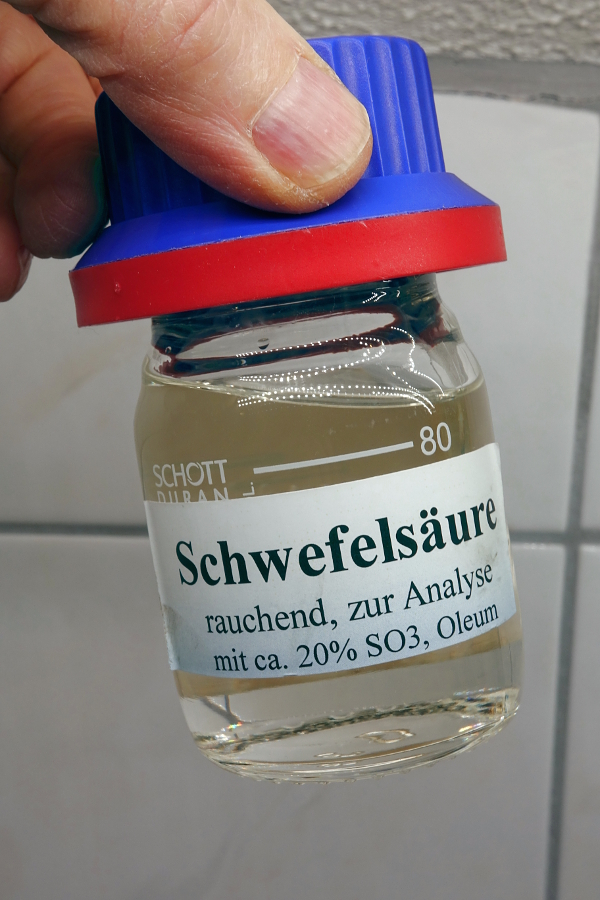
![]() Crush a little amount of
potassium chlorate, such that a fairly fine powder is
obtained. If the solid already is a fairly fine powder,
or consists of little (less than around 0.3 mm size)
crystals, then it can be used as is.
Crush a little amount of
potassium chlorate, such that a fairly fine powder is
obtained. If the solid already is a fairly fine powder,
or consists of little (less than around 0.3 mm size)
crystals, then it can be used as is.
![]() Add the potassium chlorate to
the test tube with oleum. Only add a tiny
amount! A little pile of 2 mm diameter and
2 mm height is more than enough. This will be 20 mg or
so.
Add the potassium chlorate to
the test tube with oleum. Only add a tiny
amount! A little pile of 2 mm diameter and
2 mm height is more than enough. This will be 20 mg or
so.
After adding the potassium chlorate,
the solid slowly dissolves. Around the crystals, there
is a scarlet red color. In thin layers, the newly formed
product looks bright orange/red. On dilution, the
solution also looks bright orange/red. No gas is
produced.
This is in strong
contrast with adding potassium chlorate to concentrated
(appr. 96%) sulfuric acid. If that is done, then some
orange color can be observed, but there also is
production of quite some bright yellow gas, which is ClO2.
With sulfuric acid, the chlorate ions are protonated and
HClO3 is formed, which is not stable under
these conditions. This disproportionates (more details
are given below in the explanation of the observed
results) and one of the products is ClO2.
Some of the small crystals of potassium chlorate were sticking to the walls of the test tube, which were wetted with oleum. These little crystals slowly dissolve and produce an intensely colored solution. The main body of the solution is bright orange/red.
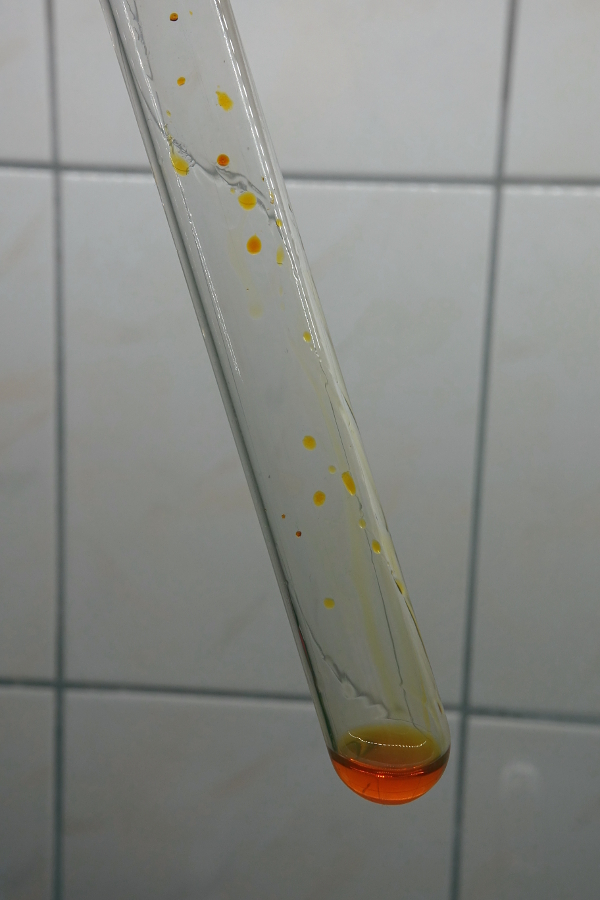
![]()
Production of a little
more of the red compound
After this experiment, some confidence was obtained, that this compound does not decompose or explode at once. It is sufficiently stable to be observed and it was decided to make a little more of this. For that purpose, the following steps were performed.
![]() Take a perfectly dry test
tube and put 1 ml of 20% oleum in the test tube and
add 5 ml or so of reagent grade concentrated sulfuric
acid to that. Swirl the test tube to mix both liquids.
This results in formation of a colorless liquid, which
hardly fumes in contact with air. This liquid is
sulfuric acid, with just a few percent of free SO3
in it. Immediately after mixing, this liquid is quite
hot. This heat is due to the reaction between the SO3
in the oleum and the few percent of water in the
concentrated sulfuric acid.
Take a perfectly dry test
tube and put 1 ml of 20% oleum in the test tube and
add 5 ml or so of reagent grade concentrated sulfuric
acid to that. Swirl the test tube to mix both liquids.
This results in formation of a colorless liquid, which
hardly fumes in contact with air. This liquid is
sulfuric acid, with just a few percent of free SO3
in it. Immediately after mixing, this liquid is quite
hot. This heat is due to the reaction between the SO3
in the oleum and the few percent of water in the
concentrated sulfuric acid.
![]() Let the liquid cool down and
then pour the liquid into the test tube with the
orange solution. Swirl the test tube with the orange
solution. The result is a paler orange liquid, due to
the dilution with the newly added acid. No noticeable
heat is produced. Apparently, all water in the
concentrated sulfuric acid was used up already in the
reaction with the oleum in the other test tube.
Let the liquid cool down and
then pour the liquid into the test tube with the
orange solution. Swirl the test tube with the orange
solution. The result is a paler orange liquid, due to
the dilution with the newly added acid. No noticeable
heat is produced. Apparently, all water in the
concentrated sulfuric acid was used up already in the
reaction with the oleum in the other test tube.
![]() Add a small spatula of
potassium chlorate to the pale orange liquid and swirl
the test tube. Do not use a large amount! A pile of 3
to 4 mm with a height of a few mm is more than enough.
The total amount of potassium chlorate should not
exceed 70 mg or so. Add the solid in small portions
and dissolve one portion, before adding the next.
Add a small spatula of
potassium chlorate to the pale orange liquid and swirl
the test tube. Do not use a large amount! A pile of 3
to 4 mm with a height of a few mm is more than enough.
The total amount of potassium chlorate should not
exceed 70 mg or so. Add the solid in small portions
and dissolve one portion, before adding the next.
After adding all potassium chlorate
and dissolving this, a beautiful deep orange/red
solution is obtained, which sticks to the glass easily
and has a very intense color, even when viewed through a
thin layer, sticking to the glass. No gas is observed,
not even a faint yellow color of ClO2 can be
observed above the liquid. There also is no smell of ClO2.
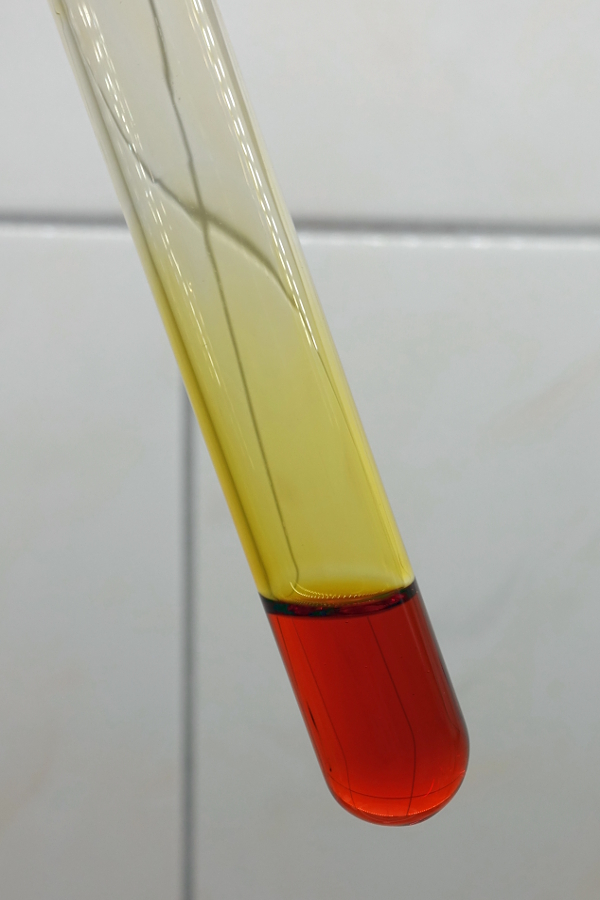
This solution is estimated to have an
SO3 content of approximately 5% by weight.
The exact concentration is not important. As long as
there is any free SO3, there will be no
water. SO3 and water simply cannot coexist.
This solution has ClO2+
ions. These ions are called chloryl
ions. Besides these, there are K+ ions from
the KClO3. According to literature, chloryl
ions have a red color. Chloryl can also be present in
covalent form, such as in ClO2F. In that
case, it is colorless.
![]()
A few experiments with the red/orange solution of chloryl ions
A few experiments were performed with this red solution:
- Dripping the solution on some red
phosphorus
- Adding some of the solution to a large excess amount of water
- Keeping the solution in contact with air for a while
- Adding some chlorosulfonic acid to the orange/red solution
In the experiments, it was surprising to see that the reactivity of the solution is not that extreme. Its reactivity is mainly because of the SO3-content, and much less so due to the presence of the chloryl ions.
The result of the first experiment is
that no visible reaction occurs. This is in strong
contrast with the situation in which red phosphorus,
potassium chlorate and sulfuric acid are mixed. In the
latter case, there is an explosion.
The result of the second experiment is
as expected. On dilution, a lot of heat is produced
(reaction of the SO3 and sulfuric acid with
water). The resulting solution is (nearly) colorless.
The chloryl ions are hydrolysed to colorless chloric
acid, which in turn dissociates to chlorate ions and
hydrated hydrogen ions.
When the solution is kept in contact
with air, then it fairly quickly (in several minutes)
loses its orange color. It absorbs water vapor from the
air and in this process the chloryl hydrolyses.
The final experiment was adding
chlorosulfonic acid to the red solution. When the
chlorosulfonic acid is added to the solution carefully,
then two layers are formed, with a diffuse border
between the layers. The density of the chlorosulfonic
acid is lower than the density of the red solution. It
floats on top, as a pale yellow liquid.
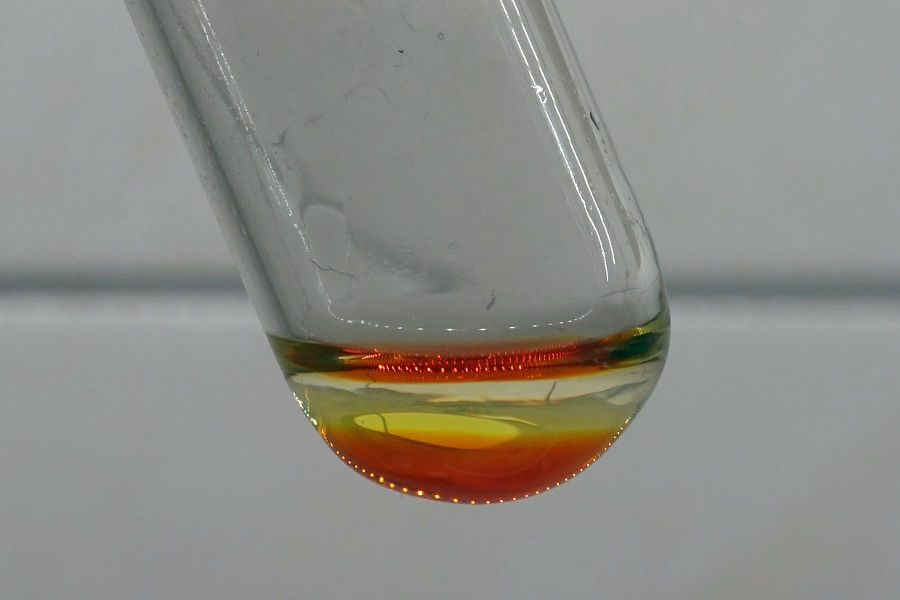
Where the two layers meet, there is a yellow color. Probably this is due to dilution of the orange liquid, combined with reaction. Sometimes a bubble of gas is formed at the border between the two layers, which quickly grows and then goes to the surface. There, however, is not a constant production of bubbles.
When the liquid is shaken, then there is foaming of the liquid and a larger amount of gas is produced.
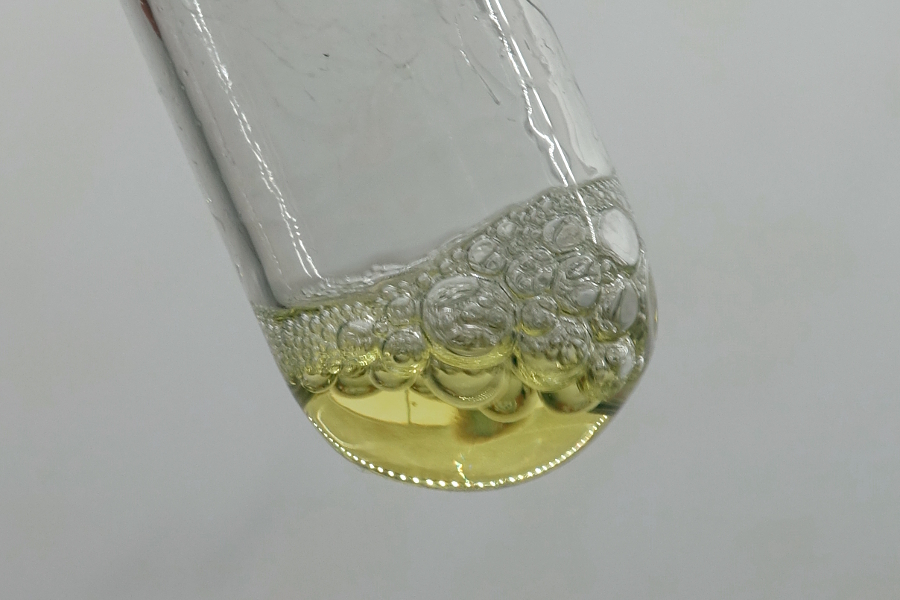
The gas, which is produced is colorless (or very pale green, hard to observe). There is a strong smell of chlorine though, so most likely it is chlorine gas. At least it contains quite some chlorine gas. No ClO2 is produced. The latter has an intense yellow color and a distinct odor, which is not observed. After shaking, the production of gas quickly ceases. At each shake, again a little gas is produced. The liquid has a yellow color, as shown in the picture above. At the end of this experiment, the liquid was poured in a bucket full of water. It dissolves in the water, making a hissing noise (it contains a lot of chlorosulfonic acid), producing a colorless solution.
![]()
Discussion of results
![]() When potassium chlorate is
added to concentrated sulfuric acid (96% or so), then a
lot of yellow gas is produced and at the same time,
white fumes are produced. The following reaction occurs:
When potassium chlorate is
added to concentrated sulfuric acid (96% or so), then a
lot of yellow gas is produced and at the same time,
white fumes are produced. The following reaction occurs:
KClO3 + H2SO4 HClO3 + K+ + HSO4–
HClO3 is quite a
strong acid, but sulfuric acid is stronger and this
protonates the chlorate ion in potassium chlorate. HClO3
is not stable as a covalent molecule. Only when it can
act as acid and form H+ and ClO3– it is
stable. This is the case in aqueous solutions up to
appr. 30% by weight. The covalent, not dissociated
compound, disproportionates as follows:
3 HClO3
HClO4 + 2 ClO2
+ H2O
The ClO2 escapes as bright
yellow gas. Both ClO2 and anhydrous HClO4
are very unstable and frequently, this reaction leads
to explosion. The H2O immediately is
absorbed by excess H2SO4.
![]() When
potassium chlorate is added to sulfuric acid, containing
free SO3, then a different reaction occurs:
When
potassium chlorate is added to sulfuric acid, containing
free SO3, then a different reaction occurs:
KClO3 + SO3 ClO2+ + K+ + SO42–
The SO42–
ion, then in turn, will react with H2SO4,
present in the liquid, to HSO4–
ions.
The ion ClO2+ has a red color. It is called chloryl ion.
Solid salts of the chloryl ion have
been prepared, but doing that can only be done in a very
well equipped lab and is not something for the home
chemist. Some examples of chloryl salts, which have been
isolated are ClO2SbF6 and ClO2ClO4.
These are red ionic compounds.
The chloryl ion is very reactive and
as soon as it comes in contact with water, it is
hydrolysed:
ClO2+
+ 2 H2O
HClO3 + H3O+
If there is a large excess amount of
water, then the HClO3 dissociates and acts as
acid. This is quite a strong acid, so most of it will be
ionized as follows:
HClO3
+ H2O
ClO3–
+ H3O+
If only a little water is added, then
the HClO3
decomposes, giving ClO2
and HClO4.
![]() The reaction with
chlorosulfonic acid is a simple redox reaction.
Chlorosulfonic acid contains chlorine in oxidation state
-1 and the chloryl ion contains chlorine in oxidation
state +5, so there is an easy target for oxidation. The
complete redox reaction is as follows:
The reaction with
chlorosulfonic acid is a simple redox reaction.
Chlorosulfonic acid contains chlorine in oxidation state
-1 and the chloryl ion contains chlorine in oxidation
state +5, so there is an easy target for oxidation. The
complete redox reaction is as follows:
ClO2+
+ 5 HSO3Cl + HSO4–
3 Cl2 + 3 H2S2O7
In the equation is written H2S2O7, which most likely
is a simplification of what really happens. In oleum,
there is a complicated equilibrium mix of pyrosulfate,
free SO3, HSO4–
and H2SO4.
The essence of this equation is that the chloryl ion
oxidizes the chlorosulfonic acid and forms chlorine
gas.
Unfortunately not much
information about chloryl ion and its compounds
can be found online. Wikipedia has a brief page on it, giving its
color and some basic information.